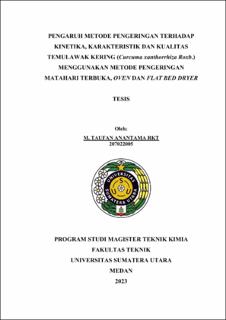| dc.description.abstract | Drying is one of the oldest preservation methods where heat is
transferred from the environment to the wet material by convection /
conduction / radiation thereby evaporating the water contained in the
material. Drying Curcuma xhantorriza roxb aims to extend the shelf life,
maintain the active substance content in the ingredients, and facilitate
subsequent processing. In this research, Curcuma xhantorriza roxb was
dried using the open sun drying method (variations in hot weather,
normal weather and cloudy weather with a thickness of 5, 10 and 15
mm). Oven (temperature variations 50, 60 and 70 oC with thicknesses of
5, 10 and 15 mm), and flat bed dryer (FBD) as a comparison of the two
methods which are operated at a temperature of 50 oC with a thickness of
5 mm. Next, the drying results will be compared based on the
curcuminoid content of dried curcuma xhantorriza roxb. In addition, a
study was carried out on changes in the surface morphology of curcuma
before and after drying and determined the drying kinetics model from
the five models used, namely the diffusion approach, page, two terms,
logarithmic and Verma et. al. The results obtained from drying curcuma
using the open sun drying method, oven and FBD is dried curcuma with
moisture content respectively amounting to 7.35% (wb); 0.92 % (wb);
and 9.08% (wb). The time needed to dry curcuma is 30.33 hours (open
sun), 12 hours (oven) and 9.33 hours (FBD). Analysis results
Spectrophotometer UV-VIS to determine curcuminoid levels in fresh and
dried curcuma is 1.36% and 0.36% (Open Sun); 3.22 % and 2.91 %
(Oven); 2.64 % and 2.34 % (FBD). The results Analisys used Scanning
Electron Microscope (SEM) on fresh and dried curcuma from drying in
the open sun (hot weather), oven (50oC) and FBD (50oC) that is, in fresh
curcuma you can see that the surface microstructure has many pores and
small porosity, whereas in dry curcuma there is a change in surface
microstructure causing the pores to close and porosity to increase. The
kinetic model that is suitable for describing the drying mechanism in this
research is the diffusion approach model for the open sun and oven
drying methods, while for the flat bed dryer it is the logarithmic model.
The best drying method produced in this research is the oven drying
method. | en_US |





